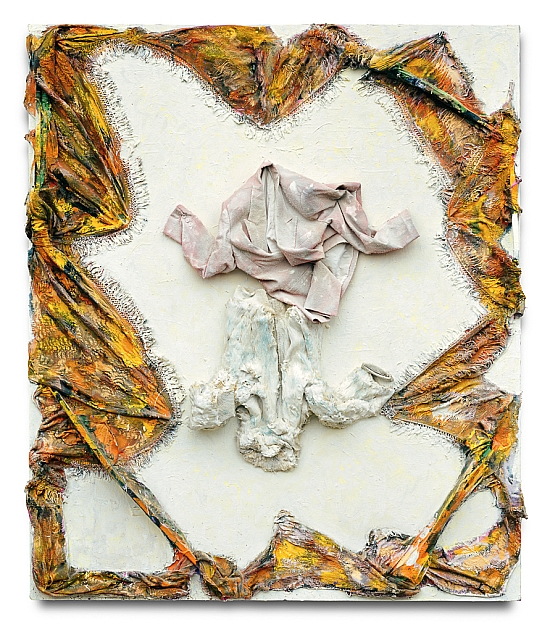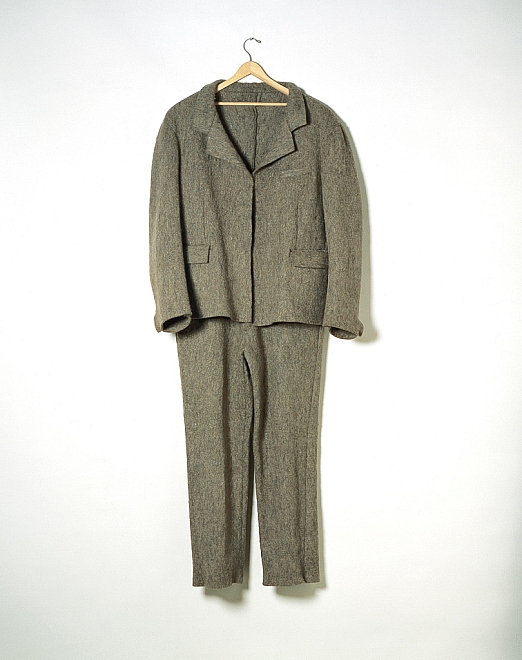Two Coats
In Two Coats Dial again re-signs a representative icon of the fine-art world, responding antiphonally to Felt Suit, created in 1970 by conceptual artist Joseph Beuys. He encountered the Beuys work while visiting the Philadelphia Museum of Art in 1998 for the opening of the exhibition Self-Taught Art of the Twentieth Century: An American Anthology, which included several Dial pieces. Accompanied on his visit by fellow artists Lonnie Holley and Purvis Young, he was fascinated by the Beuys and wondered how a mere suit made of gray felt and hung on a coat hanger could be exhibited in an art museum. The encounter provoked for Dial many questions about the nature of art and the values of the art world. More specifically, it led him to wonder about the power and privilege that Beuys must have possessed in order to have such a seemingly unassuming object included in a prestigious museum. Five years later, Dial’s continued musings on the meaning of Beuys’s hanging jacket and trousers found expression in a piece that he appropriately called Two Coats.
Like Beuys’s Felt Suit, Dial’s Two Coats uses literal objects as its subject matter. Attached to the center of the picture plane are two coats, one upright and the other positioned upside down as if to form a mirror image. The top coat, stylishly designed and tailored with well-cut lapels, represents a piece of formal or business attire. Appearing just below is a second coat, which is made of dirty faux fur. Cheap and disheveled, Dial’s second coat serves as a foil to the more graceful and distinguished jacket above, as a kind of debased or netherworld refection of its high-style twin.
Dial’s strangely disparate coats signify the relationship between the high and the low, between those at the top and those on the bottom. Another example of Dial’s ongoing examination of social and economic hierarchy, it illustrates the classic dynamic underlying the play of cultural hegemony, the fact that there can be no high without a corresponding low, no powerful and privileged group can exist without another group whose privilege and power is denied. Like Dial’s two coats, the powerful and the less powerful are always symbiotically connected, equally enmeshed within the prevailing system of social ideology that keeps them fixed within their hierarchical relationship.
Signifying on the concept of “twoness,” Dial’s Two Coats also references one of the most important ideas in African American literary history—the profound recognition that identity for black Americans is situated in two mutually dependent yet contradictory realities, the double-consciousness of being both black and American. Writing in his seminal book The Souls of Black Folk, black activist and scholar W. E. B. Du Bois described this essential twoness of black life in America, the contradiction between the promise of American democratic values and the harsh realities of African American social history. According to Du Bois: “One ever feels his twoness—an American, a Negro; two souls, two thoughts, two unreconciled strivings; two warring ideals in one dark body, whose dogged strength alone keeps it from being torn asunder.”
The existential contradiction described by Du Bois is a central theme of Dial’s Two Coats and many of his other works. But here Dial employs the symbol of twoness for other reasons as well. Most obviously, the title refers to the two real coats that make up his composition and to his tongue-in-cheek competitive redoubling of Beuys’s original accomplishment. It is also a humorous wordplay on the fact that Dial has applied two coats of pigment to the surface of his canvas. In creating this piece, the artist completely overpainted a work of art he had begun thirteen years earlier, covering everything with white pigment except for the twisted outline of brown and gold fabric that frames the image. The whiteness of Dial’s composition conjures many allusions—to the white museum wall on which the Beuys suit hangs, to the predominant whiteness of the mainstream art world, to the necessity of donning whiteness in order to survive and succeed in a racist society, and to the wearing of Paul Laurence Dunbar’s metaphorical mask that “grins and lies” in order to hide our “tears and sighs.” In still another sense, Dial’s second coat of paint serves as a further competitive exchange with Beuys himself, in which Dial attempts to outdo Beuys at his own artistic game. Just as an accomplished house painter or auto-body repairman would apply multiple layers of paint to signify care and skill, so Dial applies two coats to his work to symbolize his experience and abilities as an artist.
Drupal Theme and Development By: Cheeky Monkey Media
Site Design By: Constructive

